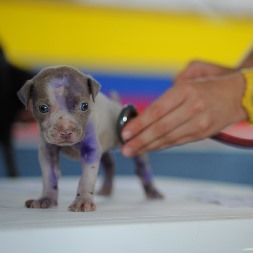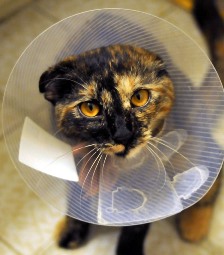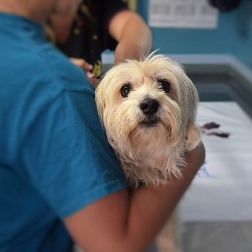How to Select a Vet Tech School near Peru Indiana
 Achieving your long term aspiration of working with and caring for animals by enrolling in a vet tech school near Peru IN may initially seem like a challenging endeavor. After all, you need to find and enroll in a school that will provide the appropriate training to ensure that you can succeed as a veterinary technician. But just how do you approach assessing and comparing colleges so that you can make the proper selection? Many aspiring students start their due diligence process by searching for colleges that are near their homes. Once they have located some area colleges, they find out which ones have the cheapest tuition and focus on those. Although cost and location are significant considerations when comparing vet tech programs, they are by no means the only critical ones when making your evaluations. Qualifications such as internship programs and accreditation need to be evaluated as well. The main idea is that there are questions you need to be asking the vet technician schools you are considering before you make a final decision. We have presented several in this article to help get you started, but before we review them we’ll talk about the varied responsibilities of veterinary technicians and the training options offered.
Achieving your long term aspiration of working with and caring for animals by enrolling in a vet tech school near Peru IN may initially seem like a challenging endeavor. After all, you need to find and enroll in a school that will provide the appropriate training to ensure that you can succeed as a veterinary technician. But just how do you approach assessing and comparing colleges so that you can make the proper selection? Many aspiring students start their due diligence process by searching for colleges that are near their homes. Once they have located some area colleges, they find out which ones have the cheapest tuition and focus on those. Although cost and location are significant considerations when comparing vet tech programs, they are by no means the only critical ones when making your evaluations. Qualifications such as internship programs and accreditation need to be evaluated as well. The main idea is that there are questions you need to be asking the vet technician schools you are considering before you make a final decision. We have presented several in this article to help get you started, but before we review them we’ll talk about the varied responsibilities of veterinary technicians and the training options offered.
The Role of a Veterinary Technician in Peru IN
 One of the first decisions that you will need to make is if you wish to train as a veterinary assistant, technician or technologist. Part of your decision might be based on the amount of time and money that you have to commit to your training, but the main determiner will undoubtedly be which specialty interests you the most. What technicians and assistants share in common is that they both work under the direct guidance of a licensed and practicing veterinarian. And although there are many duties that they can carry out within the Peru IN veterinary practice or hospital, they can’t prescribe medications, diagnose ailments, or perform surgeries. In those areas they can only provide support to a licensed vet. There are technologists and technicians that work away from the conventional veterinarian practice, for example for animal shelters, zoos or law enforcement. Let’s take a look at the duties and education requirements for each specialization.
One of the first decisions that you will need to make is if you wish to train as a veterinary assistant, technician or technologist. Part of your decision might be based on the amount of time and money that you have to commit to your training, but the main determiner will undoubtedly be which specialty interests you the most. What technicians and assistants share in common is that they both work under the direct guidance of a licensed and practicing veterinarian. And although there are many duties that they can carry out within the Peru IN veterinary practice or hospital, they can’t prescribe medications, diagnose ailments, or perform surgeries. In those areas they can only provide support to a licensed vet. There are technologists and technicians that work away from the conventional veterinarian practice, for example for animal shelters, zoos or law enforcement. Let’s take a look at the duties and education requirements for each specialization.
- Vet Assistants in the majority of instances will have gone through a formal training program, either as an apprentice or intern in a vet clinic or hospital, or by graduating from a certificate program at a trade school or community college. As the name implies, their job function is to assist the vets and vet technicians in the execution of their duties. Normally they are not involved with more complex activities, for instance assisting with surgical procedures. Some of their normal responsibilities may include working at the front desk, preparing and cleaning examination rooms and equipment, or handling animals during examinations.
- Vet Technicians undergo more advanced training compared with assistants and typically obtain a two year Associate Degree, ideally from an American Veterinary Medical Association (AVMA) accredited program. They are in a fashion the vet equivalent of medical nurses, since their basic job function is to assist vets with diagnosing and treating animal patients. Where they stand apart from vet assistants is that they are included in more involved duties, for example assisting with surgical procedures or providing medicine. All states presently require veterinary technicians pass a credentialing exam for either licensing, registration or certification.
- Vet Technologists are comparable to veterinary techs and essentially carry out the same job functions. They are mandated to attain a Bachelor’s Degree in veterinary technology, which usually requires 4 years to complete. So the main difference between a vet technologist and a technician is the technologist’s higher level of education. But with an advanced degree comes more job opportunities, higher salaries and possible management positions. They are also mandated to pass a credentialing exam for either licensing, registration or certification.
Vet techs and technologists may specialize in areas such as anesthesia, internal medicine or emergency care. Some may acquire certification from the American Association for Laboratory Animal Science (AALAS) to work in Peru IN laboratories or research facilities as well.
Online Vet Tech Schools Offered in Peru
 An approach that may be a solution for those with a busy schedule or who are working full-time while attending vet college is to enroll in an online training program. Since the classes are offered via the internet, students can attend on their own timetable wherever a computer is available. The educational program is taught using several methods, including videos, slide shows and live streaming webinars. And since most veterinary tech and technologist degrees require clinical training, that part can normally be completed as an internship or work study program at a local Peru IN veterinarian clinic or hospital. Distance learning, as it is also called, may in some instances decrease the cost of your education. Tuition and ancillary expenditures, for instance for traveling and study materials, can be lower compared to more conventional classroom programs. Just make certain that the program that you enroll in is accredited, either by the AVMA or another nationally certified accrediting agency. With the online classes and the clinical training, everything is furnished for a comprehensive education. So if you are dedicated enough to learn in this more self-reliant manner, an online veterinary technician school may be the ideal option for you.
An approach that may be a solution for those with a busy schedule or who are working full-time while attending vet college is to enroll in an online training program. Since the classes are offered via the internet, students can attend on their own timetable wherever a computer is available. The educational program is taught using several methods, including videos, slide shows and live streaming webinars. And since most veterinary tech and technologist degrees require clinical training, that part can normally be completed as an internship or work study program at a local Peru IN veterinarian clinic or hospital. Distance learning, as it is also called, may in some instances decrease the cost of your education. Tuition and ancillary expenditures, for instance for traveling and study materials, can be lower compared to more conventional classroom programs. Just make certain that the program that you enroll in is accredited, either by the AVMA or another nationally certified accrediting agency. With the online classes and the clinical training, everything is furnished for a comprehensive education. So if you are dedicated enough to learn in this more self-reliant manner, an online veterinary technician school may be the ideal option for you.
Things to Ask Peru IN Veterinary Technician Colleges
 At this point you probably have determined which veterinarian credential that you wish to attain, and if you want to study online or attend a program on campus. Since there are an abundance of veterinary community colleges, vocational and trade schools in the Peru IN area as well as across the Country, you must ask some important questions in order to fine tune your list of options. As we discussed in our introduction, many future students start by prioritizing location and the cost of tuition. But we have already pointed out other essential qualifiers, for example internship programs and accreditation. And naturally you want to select a college that offers the specialty and degree that you are interested in. These and other qualifications are addressed in the list of questions that you need to ask the veterinary technician programs that you are looking at.
At this point you probably have determined which veterinarian credential that you wish to attain, and if you want to study online or attend a program on campus. Since there are an abundance of veterinary community colleges, vocational and trade schools in the Peru IN area as well as across the Country, you must ask some important questions in order to fine tune your list of options. As we discussed in our introduction, many future students start by prioritizing location and the cost of tuition. But we have already pointed out other essential qualifiers, for example internship programs and accreditation. And naturally you want to select a college that offers the specialty and degree that you are interested in. These and other qualifications are addressed in the list of questions that you need to ask the veterinary technician programs that you are looking at.
Is the Veterinary College Accredited? It’s imperative that you make sure that the vet tech program you select is accredited by a regional or national accrediting organization. As earlier mentioned, one of the most highly respected is the American Veterinary Medical Association (AVMA). Vocational schools and colleges that are accredited by the AVMA have undergone a demanding screening process that confirms you will obtain a superior education. Also, accreditation is necessary if you are requesting a student loan or financial aid, since many programs are not available for non-accredited colleges. Last, having a degree or certificate from an accredited school is often a prerequisite for employment for a number of Peru IN area veterinarian clinics and hospitals.
What is the College’s Reputation? The veterinarian college or trade school and program you select must have an exceptional reputation within the veterinarian community. You can initiate your due diligence by asking the schools you are reviewing for endorsements from the employers in their job assistance network. Other tips include checking with internet school ranking websites and speaking with the school’s accrediting organizations as well. You can ask the Indiana school licensing authority if there have been any grievances or violations regarding your specific schools. As a final tip, get in touch with some Peru IN veterinary clinics that you might wish to work for after you go through your training. Ask what they think of your school choices. They might even recommend one or more schools not on your list.
Are Internships Offered? The best approach to get clinical hands on training as a vet tech is to work in a medical environment. Ask if the schools you are looking at have internship programs arranged with Peru IN veterinarians, vet hospitals or clinics. The majority of veterinary medicine programs mandate clinical training and a large number furnish it through internships. Not only will the experience be invaluable regarding the clinical training, but an internship may also help build connections in the local vet community and assist in the search for employment after graduation.
Is there a Job Placement Program? Searching for a job after graduating from a veterinary technician program may be difficult without the help of a job placement program. To start with, find out what the graduation rates are for the schools you are evaluating. A low rate could indicate that the teachers were ineffective at teaching the syllabus or that a number of students were disappointed with the program and dropped out. Next, confirm that the colleges have a job assistance program and ask what their placement rates are. A high placement rate may mean that the college has an excellent reputation within the Peru IN veterinary community and has a significant network of contacts for student placements. A lower rate may indicate that the training is not highly thought of by employers or that the job placement program is ineffective at placing students.
How Big are the Classes? If the classes are larger, you most likely will get little or no one-on-one instruction from the teachers. Solicit from the Peru IN programs you are researching what their class student to teacher ratios are. You may also want to participate in some classes (if practical) to monitor the interaction between instructors and students. Ask for feedback from students regarding the quality of instruction. Also, speak with the teachers and find out what their backgrounds are as well as their methods of teaching.
Where is the School Located? Yes, we already discussed location, but there are several more points to consider on the topic. If you are going to commute to your veterinary technician classes from your Peru IN home, you must make sure that the driving time is compatible with your schedule. For instance, driving during the weekend to investigate the route won’t be the same as the commute during rush hour traffic, especially if the college is located in or close by a large city. Also, if you do choose to enroll in a college in another state or even outside of your County of residence, there may be higher tuition costs particularly for community and state colleges. Of course attending classes online could be an alternative that will provide you with more flexibility and decrease the necessity for travel.
Do the Classes Fit Your Schedule? And finally, it’s imperative that you find out if the veterinary colleges you are exploring offer class times flexible enough to fit your schedule. For instance, a number of students continue to work full time and can only go to classes on the weekends or at night near Peru IN. Others may only be able to go to class in the morning or later in the afternoon. Make sure that the class times you need are available before enrolling. Also, find out if you can make-up classes that you may miss as a result of work, illness or family responsibilities. You might discover that an online college is the ideal solution to fit your veterinary training into your active life.
Enrolling in a Vet Tech School near Peru IN?
If you have decided to attend a Veterinary Technician Program in the Peru Indiana area, then you may find the following information about the location of your school campus interesting and informing.
Peru
Peru (/pəˈruː/ ( listen); Spanish: Perú [peˈɾu]; Quechua: Piruw Republika [pʰɪɾʊw];[8]Aymara: Piruw Suyu [pɪɾʊw]), officially the Republic of Peru (Spanish: República del Perú (help·info)), is a country in western South America. It is bordered in the north by Ecuador and Colombia, in the east by Brazil, in the southeast by Bolivia, in the south by Chile, and in the west by the Pacific Ocean. Peru is an extremely biodiverse country with habitats ranging from the arid plains of the Pacific coastal region in the west to the peaks of the Andes mountains vertically extending from the north to the southeast of the country to the tropical Amazon Basin rainforest in the east with the Amazon river.[9]
Peruvian territory was home to several ancient cultures, ranging from the Norte Chico civilization in the 32nd century BC, the oldest civilization in the Americas, to the Inca Empire, the largest and most sophisticated state in pre-Columbian America. The Spanish Empire conquered the region in the 16th century and established a Viceroyalty that encompassed most of its South American colonies, with its capital in Lima. Peru formally proclaimed independence in 1821, and following the military campaigns of José de San Martín and Simón Bolívar, and the decisive battle of Ayacucho, Peru secured independence in 1824. In the ensuing years, the country enjoyed relative economic and political stability, which ended shortly before the War of the Pacific with Chile. Throughout the 20th century, Peru endured armed territorial disputes, coups, social unrest, and internal conflicts, as well as periods of stability and economic upswing. Alberto Fujimori was elected to the presidency in 1990; his government was credited with economically stabilizing Peru and successfully ending the Shining Path insurgency, though he was widely accused of human rights violations and suppression of political dissent. Fujimori left the presidency in 2000 and was charged with human rights violations and imprisoned until his pardon by President Pedro Pablo Kuczynski in 2017.
The sovereign state of Peru is a representative democratic republic divided into 25 regions. It is classified as an emerging market[10] with a high level of human development[11] and an upper middle income level[12] with a poverty rate around 19 percent.[13] It is one of the region's most prosperous economies with an average growth rate of 5.9%[13] and it has one of the world's fastest industrial growth rates at an average of 9.6%.[14] Its main economic activities include mining, manufacturing, agriculture and fishing; along with other growing sectors such as telecommunications and biotechnology.[15] The country forms part of The Pacific Pumas, a political and economic grouping of countries along Latin America’s Pacific coast that share common trends of positive growth, stable macroeconomic foundations, improved governance and an openness to global integration. Peru ranks high in social freedom[16] and it has the third lowest homicide rate in South America; it is an active member of the Asia-Pacific Economic Cooperation, the Pacific Alliance, the Trans-Pacific Partnership and the World Trade Organization; and is considered as a middle power.[17]
Choose the Right Veterinary Technician Program near Peru IN
 Selecting the right veterinary technician program is a critical first step to beginning a fulfilling career delivering care and treatment for animals. Potential students considering veterinary technician colleges must make their decision based on multiple key factors. Veterinary technicians and technologists work in veterinary clinics and hospitals and animal shelters. They usually take on administrative responsibilities and assist the veterinarian with the animal patients when needed. As we have discussed, it’s very important that you select a veterinary medicine program that is both accredited and has an excellent reputation within the profession. This goes for online vet tech programs as well. By asking the questions provided in our checklist for assessing schools, you will be able to narrow down your options so that you can make your final decision. And by choosing the right program, you can accomplish your goal of becoming a vet tech in Peru IN.
Selecting the right veterinary technician program is a critical first step to beginning a fulfilling career delivering care and treatment for animals. Potential students considering veterinary technician colleges must make their decision based on multiple key factors. Veterinary technicians and technologists work in veterinary clinics and hospitals and animal shelters. They usually take on administrative responsibilities and assist the veterinarian with the animal patients when needed. As we have discussed, it’s very important that you select a veterinary medicine program that is both accredited and has an excellent reputation within the profession. This goes for online vet tech programs as well. By asking the questions provided in our checklist for assessing schools, you will be able to narrow down your options so that you can make your final decision. And by choosing the right program, you can accomplish your goal of becoming a vet tech in Peru IN.
Other Doggone Good Cities in Indiana
Business Results 1 - 10 of 11











